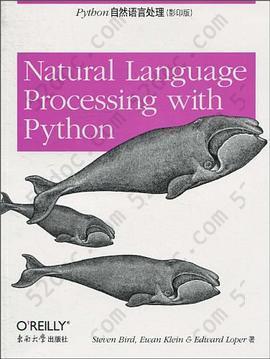注重体验与质量的电子书资源下载网站
分类于: 人工智能 设计
简介

Python自然语言处理 豆 8.1分
资源最后更新于 2020-08-20 13:56:34
作者:(英)伯德
出版社:东南大学出版社
出版日期:2010-01
ISBN:9787564122614
文件格式: pdf
标签: 自然语言处理 python NLP Python 自然语言 数据挖掘 计算机 编程
简介· · · · · ·
《Python自然语言处理(影印版)》提供了非常易学的自然语言处理入门介绍,该领域涵盖从文本和电子邮件预测过滤,到自动总结和翻译等多种语言处理技术。在《Python自然语言处理(影印版)》中,你将学会编写Python程序处理大量非结构化文本。你还将通过使用综合语言数据结构访问含有丰富注释的数据集,理解用于分析书面通信内容和结构的主要算法。
《Python自然语言处理》准备了充足的示例和练习,可以帮助你:
从非结构化文本中抽取信息,甚至猜测主题或识别“命名实体”;
分析文本语言结构,包括解析和语义分析;
访问流行的语言学数据库,包括WordNet和树库(treebank);
从多种语言学和人工智能领域中提取的整合技巧。
《Python自然语言处理(影印版)》将帮助你学习运用Python编程语言和自然语言工具包(NLTK)获得实用的自然语言处理技能。如果...
目录
Preface
1.Language Processing and Python
1.1 Computing with Language: Texts and Words
1.2 A Closer Look at Python: Texts as Lists of Words
1.3 Computing with Language: Simple Statistics
1.4 Back to Python: Making Decisions and Taking Control
1.5 Automatic Natural Language Understanding
1.6 Summary
1.7 Further Reading
1.8 Exercises
2.Accessing Text Corpora and Lexical Resources
2.1 Accessing Text Corpora
2.2 Conditional Frequency Distributions
2.3 More Python: Reusing Code
2.4 Lexical Resources
2.5 WordNet
2.6 Summary
2.7 Further Reading
2.8 Exercises
3.Processing Raw Text
3.1 Accessing Text from the Web and from Disk
3.2 Strings: Text Processing at the Lowest Level
3.3 Text Processing with Unicode
3.4 Regular Expressions for Detecting Word Patterns
3.5 Useful Applications of Regular Expressions
3.6 Normalizing Text
3.7 Regular Expressions for Tokenizing Text
3.8 Segmentation
3.9 Formatting: From Lists to Strings
3.10 Summary
3.11 Further Reading
3.12 Exercises
4.Writing Structured Programs
4.1 Back to the Basics
4.2 Sequences
4.3 Questions of Style
4.4 Functions: The Foundation of Structured Programming
4.5 Doing More with Functions
4.6 Program Development
4.7 Algorithm Design
4.8 A Sample of Python Libraries
4.9 Summary
4.10 Further Reading
4.11 Exercises
5.Categorizing andTagging Words
5.1 Using a Tagger
5.2 Tagged Corpora
5.3 Mapping Words to Properties Using Python Dictionaries
5.4 Automatic Tagging
5.5 N-Gram Tagging
5.6 Transformation-Based Tagging
5.7 How to Determine the Category of a Word
5.8 Summary
5.9 Further Reading
5.10 Exercises
6.Learning to Classify Text
6.1 Supervised Classification
6.2 Further Examples of Supervised Classification
6.3 Evaluation
6.4 Decision Trees
6.5 Naive Bayes Classifiers
6.6 Maximum Entropy Classifiers
6.7 Modeling Linguistic Patterns
6.8 Summary
6.9 Further Reading
6.10 Exercises
7.Extracting Information from Text
7.1 Information Extraction
7.2 Chunking
7.3 Developing and Evaluating Chunkers
7.4 Recursion in Linguistic Structure
7.5 Named Entity Recognition
7.6 Relation Extraction
7.7 Summary
7.8 Further Reading
7.9 Exercises
8.Analyzing Sentence Structure
8.1 Some Grammatical Dilemmas
8.2 Whats the Use of Syntax?
8.3 Context-Free Grammar
8.4 Parsing with Context-Free Grammar
8.5 Dependencies and Dependency Grammar
8.6 Grammar Development
8.7 Summary
8.8 Further Reading
8.9 Exercises
9.Building Feature-Based Grammars
9.1 Grammatical Features
9.2 Processing Feature Structures
9.3 Extending a Feature-Based Grammar
9.4 Summary
9.5 Further Reading
9.6 Exercises
10.Analyzing the Meaning of Sentences
10.1 Natural Language Understanding
10.2 Propositional Logic
10.3 First-Order Logic
10.4 The Semantics of English Sentences
10.5 Discourse Semantics
10.6 Summary
10.7 Further Reading
10.8 Exercises
11.Managing Linguistic Data
11.1 Corpus Structure: A Case Study
11.2 The Life Cycle of a Corpus
11.3 Acquiring Data
11.4 Working with XML
11.5 Working with Toolbox Data
11.6 Describing Language Resources Using OLAC Metadata
11.7 Summary
11.8 Further Reading
11.9 Exercises
Afterword: The Language Challenge
Bibliography
NLTK Index
General Index
1.Language Processing and Python
1.1 Computing with Language: Texts and Words
1.2 A Closer Look at Python: Texts as Lists of Words
1.3 Computing with Language: Simple Statistics
1.4 Back to Python: Making Decisions and Taking Control
1.5 Automatic Natural Language Understanding
1.6 Summary
1.7 Further Reading
1.8 Exercises
2.Accessing Text Corpora and Lexical Resources
2.1 Accessing Text Corpora
2.2 Conditional Frequency Distributions
2.3 More Python: Reusing Code
2.4 Lexical Resources
2.5 WordNet
2.6 Summary
2.7 Further Reading
2.8 Exercises
3.Processing Raw Text
3.1 Accessing Text from the Web and from Disk
3.2 Strings: Text Processing at the Lowest Level
3.3 Text Processing with Unicode
3.4 Regular Expressions for Detecting Word Patterns
3.5 Useful Applications of Regular Expressions
3.6 Normalizing Text
3.7 Regular Expressions for Tokenizing Text
3.8 Segmentation
3.9 Formatting: From Lists to Strings
3.10 Summary
3.11 Further Reading
3.12 Exercises
4.Writing Structured Programs
4.1 Back to the Basics
4.2 Sequences
4.3 Questions of Style
4.4 Functions: The Foundation of Structured Programming
4.5 Doing More with Functions
4.6 Program Development
4.7 Algorithm Design
4.8 A Sample of Python Libraries
4.9 Summary
4.10 Further Reading
4.11 Exercises
5.Categorizing andTagging Words
5.1 Using a Tagger
5.2 Tagged Corpora
5.3 Mapping Words to Properties Using Python Dictionaries
5.4 Automatic Tagging
5.5 N-Gram Tagging
5.6 Transformation-Based Tagging
5.7 How to Determine the Category of a Word
5.8 Summary
5.9 Further Reading
5.10 Exercises
6.Learning to Classify Text
6.1 Supervised Classification
6.2 Further Examples of Supervised Classification
6.3 Evaluation
6.4 Decision Trees
6.5 Naive Bayes Classifiers
6.6 Maximum Entropy Classifiers
6.7 Modeling Linguistic Patterns
6.8 Summary
6.9 Further Reading
6.10 Exercises
7.Extracting Information from Text
7.1 Information Extraction
7.2 Chunking
7.3 Developing and Evaluating Chunkers
7.4 Recursion in Linguistic Structure
7.5 Named Entity Recognition
7.6 Relation Extraction
7.7 Summary
7.8 Further Reading
7.9 Exercises
8.Analyzing Sentence Structure
8.1 Some Grammatical Dilemmas
8.2 Whats the Use of Syntax?
8.3 Context-Free Grammar
8.4 Parsing with Context-Free Grammar
8.5 Dependencies and Dependency Grammar
8.6 Grammar Development
8.7 Summary
8.8 Further Reading
8.9 Exercises
9.Building Feature-Based Grammars
9.1 Grammatical Features
9.2 Processing Feature Structures
9.3 Extending a Feature-Based Grammar
9.4 Summary
9.5 Further Reading
9.6 Exercises
10.Analyzing the Meaning of Sentences
10.1 Natural Language Understanding
10.2 Propositional Logic
10.3 First-Order Logic
10.4 The Semantics of English Sentences
10.5 Discourse Semantics
10.6 Summary
10.7 Further Reading
10.8 Exercises
11.Managing Linguistic Data
11.1 Corpus Structure: A Case Study
11.2 The Life Cycle of a Corpus
11.3 Acquiring Data
11.4 Working with XML
11.5 Working with Toolbox Data
11.6 Describing Language Resources Using OLAC Metadata
11.7 Summary
11.8 Further Reading
11.9 Exercises
Afterword: The Language Challenge
Bibliography
NLTK Index
General Index








